Put Class Size on the Ballot
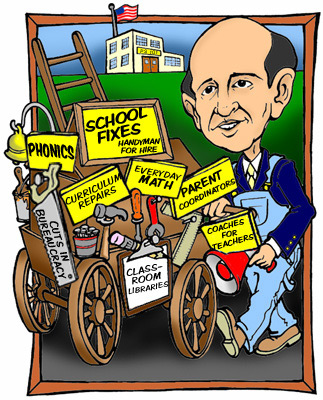 |
When school opened on September 8, class size in some elementary schools had increased 30 percent from last year's average of 25 students, Newsday reported. A number of middle schools have classes of 37 students compared to 32 in the 2002-2003 school year, and high schools are contending with nearly 1,000 more students than they had last year. In one high school in Queens, the Post found, 300 classes exceed union limits of 34 students per class, while another school in Manhattan has run out of space entirely, forcing 100 students to sit in the auditorium instead of classrooms. According to the UFT, more than 9,000 classes now violate union contractual limits on size. About the only grade level where classes have not increased in size is pre-kindergarten, since state law strictly limits those classes to 18 children per teacher.
Study after study has shown that smaller classes lead to higher grades and test scores, particularly for poor and minority students, as well as more parental involvement, fewer disciplinary problems and lower dropout rates. In their recent ruling that the state school aid formula for New York City illegally deprives city students of a sound basic education (in pdf format), judges on the state's highest court cited the city's oversized classes as key evidence that the state was providing our children with an inadequate education.
Overcrowding in city schools has endured for decades and through many administrations. Though Mayor Michael Bloomberg has acknowledged the importance of class size and promised to speed school construction and expansion, he has reduced the capital budget for schools by over $3 billion, a cut of 53 percent, according to the Independent Budget Office (in pdf format). And Chancellor Joel Klein has apparently forgotten his pledge not to allow other class sizes to increase.
Whether this fall's deterioration is due to poor management, misplaced priorities, budget cuts, a misguided interpretation of the federal No Child Left Behind law, or because students are being forced out of some larger high schools that are being broken up into new smaller high schools, it is clearer than ever before that we must address this critical problem.
Recently, a coalition was created called New Yorkers for Smaller Classes. It is composed of advocacy organizations, unions, and parent groups. On August 18, the coalition presented the city clerk with petitions signed by more than 115,000 registered voters who support the creation of a new City Charter Revision Commission that would consider limiting class size in all grades. This is more than twice the number of signatures needed to put this question on the ballot in November.
Once the charter commission is up and running, it would decide whether a proposition to limit class sizes should be put before the voters in November 2004. Members of the commission would have many other important issues to debate and consider, including what specific class sizes might be proposed and how smaller classes could be funded. Clearly it will be costly to build classrooms and to hire the additional teachers needed for smaller classes. But it would be worth it.
As Assemblymember Steve Sanders pointed out when we presented our signed petitions to the city clerk, because of the state court's decision that our schools provide an inadequate education, billions of dollars in additional state education aid are expected to flow to New York City. Moreover, economists estimate that the benefits of smaller classes are twice as great as the costs, in terms of the future earnings of high school graduates alone. Oversize classes damage the city's competitiveness, by hurting our ability to provide an educated work force. They also spur families to move to the suburbs when they have children. A recent report from the Center for an Urban Future (in pdf format) points out that the most profitable economic development the city could embark upon would be to invest in improving basic services like education, in order to "build [our] middle class and keep people in the city."
Pre-school and reducing class size are the only educational reforms that have been proven to substantially reduce the achievement gap between rich and poor, and between white and minority students. We need a city charter commission to come up with a realistic plan to limit class size for the sake of our children as well as the economic future of this city. Then, let the voters decide.
Leonie Haimson is a parent, education advocate, amd chair of Class Size Matters, an organization dedicated to achieving smaller classes in NYC public schools and a member of the New Yorkers for Smaller Classes coalition.
Related Article
School Reforms of 2003
School opened last week with a new bureaucracy, 1,200 new "parent coordinators," teaching coaches and a new standard curriculum. Will any of this fix the system?
A Brief History of Election Law in New York
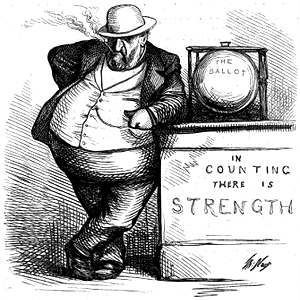 |
1665 - First Mayor
Governor Richard Nicolls appoints Thomas Willett the first "mayor of New York." For the next 156 years, the mayor will be appointed and have limited power.
1686 - Common Council
Governor Thomas Dongan divides New York City into six wards and creates a Common Council with an alderman and assistant alderman elected from each ward.
1820s - Property Qualifications Removed
In New York State, the right to vote is extended to all white males, regardless of whether they own or rent property.
1821 - Choosing a Mayor
The Common Council, which includes elected members, gains the authority to choose the mayor who will sit in City Hall. Previously, the state government appointed the mayor.
1834 - First Elected Mayor
An amendment to the state constitution provides for the direct popular election of the mayor. Cornelius W. Lawrence, a Democrat, is elected.
1846 - Voting Rights Rejected
New York voters reject a proposed amendment to the state constitution that would guarantee free blacks the same voting rights as whites.
1861 - Tammany Hall Emerges
Tammany Hall, which evolved from an organization of craftsmen into a Democratic political machine, gains control of Democratic Party nominations in the state and city.
1870 - Voting Rights
The 15th Amendment to the U.S. Constitution is ratified, giving blacks throughout the United States the same voting rights as whites.
1880 - Standard Ballot
In response to an era of political scandals, New York begins requiring the so-called "Australian ballot," a uniform ballot listing all candidates. To get on it, an office seeker would have to be nominated by a political party or submit nominating petitions, laying the groundwork for a system that persists to this day.
1890 - Primary Election
Because of perceived abuses in the way political parties select candidates, the New York State Legislature enacts a law that, for the first time, requires government to manage and pay for elections to select party officials who would then choose the party's candidates.
1892 - Voting Machine
The first voting machine, invented by Thomas Edison, is used in Lockport, New York in 1892. By the early 1920s, voting machines would be used for all general elections in New York City.
1894 - Bipartisan Control
The state establishes a system, in effect to this day, under which all election positions, from Board of Elections officials to poll watchers, must be divided equally between the two major parties.
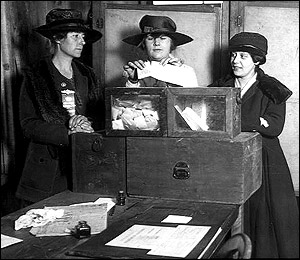 |
1898 - Greater New York Formed
A new City Charter merges Manhattan, the Bronx, Brooklyn, Queens and Staten Island into greater New York. All five boroughs now elect the mayor.
1915 - Suffragists Defeated
A referendum giving women the vote is defeated by city and state voters.
1920 - Suffragists Victorious
The 19th Amendment to the U.S. Constitution is signed into law, guaranteeing women throughout the United States the right to vote.
1965 - Opening the Polls
Congress passes the federal Voting Rights Act to ensure that no person is denied the right to vote on account of race or color.
1967 - A Black District
A suit brought under the Voting Rights Act leads to the creation of a majority black congressional district in Brooklyn. Previously, black voters had been divided among several predominantly white districts. In 1968, voters in the district elect Shirley Chisholm as the first black woman ever in the U.S. House of Representatives. Since then, congressional, state legislative and City Council districts have been drawn so as to ensure minority representation.
1969 - School Elections
Non-citizens who have children in public schools are given the right to vote in elections for members of community school boards.
1970 - Voting Rights in New York
The federal government determines that Manhattan, Brooklyn and the Bronx must be covered under the federal Voting Rights Act because of low voter registration levels. As a result, the federal government has to approve any changes in voting practices in these boroughs, including redistricting. This would mean that any switch to nonpartisan elections would require clearance by the U.S. Justice Department.
1971 - Younger Voters
The 26th Amendment lowers the voting age in New York from 21 to 18.
1975 - Multilingual Ballots and Election Information
Amendments to the Voting Rights Act require that election information be provided in Spanish as well as English in Brooklyn, the Bronx and Manhattan.
1988 - Ethical Finance
The Campaign Finance Board is formed as part of a response to corruption in city agencies. Its goal is to limit the influence of private funds in city politics. Candidates participating in the program can receive public money for their election campaigns. In return, they must agree to a spending limit and full disclosure of their campaign finances.
1989 - End of Board of Estimate
The U.S. Supreme Court abolishes the Board of Estimate, which gave each borough president an equal vote. The court rules that this violates the principle of one person-one vote because the boroughs vary so much in population. A new charter eliminates the board and distributes the board's powers between the mayor and an expanded City Council. 1992 - Chinese Ballots
The city begins providing voting information in Chinese, and Spanish is added to Queens ballots.
1993 - Term Limits
City voters approve a ballot measure, backed by millionaire Ronald Lauder, that would limit citywide officials, including the mayor, as well as borough presidents and members of the City Council to two consecutive four-year terms.
1996 - Public Debate
A law is passed requiring candidates who run for citywide office and participate in the Campaign Finance Program to participate in a series of public debates in order to receive public matching funds.
 Photograph by Steven McCurry |
1996 - Two Terms and You're Out
Voters reject a plan put forth by City Council Speaker Peter Vallone to delay the implementation of term limits and to allow officials three terms, instead of two.
2001 - Primary Date
The primary vote is originally scheduled for September 11. Voting begins that day but is halted after the attacks on the World Trade Center and postponed until September 25. With Primary Day always falling on the second Tuesday in September, some have urged the state to shift the election to keep it from ever falling on September 11. So far, such efforts have failed.
2001 - The Big Change
Because of term limits, all citywide officials and 37 of 51 City Council members are unable to run for reelection, creating the largest turnover in city history.
2003 - School Change
The state approves a law eliminating community school boards, replacing them with councils selected by parents.
2003 - Two More Years
The City Council adjusts the term limits law to allow some council members, who were elected in the middle of a term and would have had to leave office after serving fewer than eight years, to remain in their seats. The action cleared the way for Council Speaker Gifford Miller and four other members, who would have had to leave office in January, 2004, to seek re-election this November.
Ballot-Bumping in New York
 |
"In New York, politics is a blood sport."
|
This summer, Democratic City Councilmember Allan Jennings earned the distinction of being one of the few incumbent politicians in New York City ever to be kicked off the ballot by his own party.
The Queens Democratic Party, which has a history of conflict with the one-term council member and is supporting another candidate, challenged Jennings in court, claiming that the 3,300 signatures on his petitions were riddled with fake and fraudulent information.
Jennings acknowledged some minor mistakes, such as missing addresses or signatures from people who had recently moved, but denied any wrongdoing. In mid-August, State Supreme Court Justice Janice Taylor - who has received the backing of the Queens Democratic Party throughout her career - kicked Jennings off the ballot.
Jennings appealed and spent the next nine days in court. His campaign workers and volunteers were called on to testify about how, when and where they collected signatures. "All of my petition people were senior citizens and they don't remember things precisely," said Jennings.
A five-member panel of the Appellate Division eventually reversed the lower court ruling, citing "irregularities" in the petitions, but no fraud. The council member was put back on the ballot.
"I feel personally vindicated," he said later.
But Councilmember Jennings may not be the best standard-bearer for the principles of democracy. The council member himself sued all of his opponents in an effort to kick them off the ballot for the same kind of technicalities; he succeeded in narrowing the field of challengers from five to two.
"Using these type of shenanigans to deny the voters the right to choose is shameful," said Inderjit Singh, one of the two opponents who successfully defended their signatures.
In New York, which has some of the most complicated election laws in the nation, knocking your opponent off the ballot is a routine aspect of the political game. This year, dozens of candidates for City Council were eliminated on technicalities. And many more potential challengers did not even bother running, knowing that they would face huge legal bills and hours in court defending their right to run. (For a dozen council races worth watching this year, see Campaign 2003)
The process not only limits voters' choices, but it means the candidates spend more time in court than they do meeting the voters and hearing their concerns.
"In New York, politics is a blood sport," said election lawyer Henry Berger.
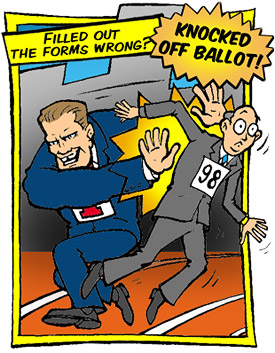 |
|
Candidates have been knocked off the ballot for such infractions as writing the abbreviation "St." instead of "Street"
|
Battle To Get On
This summer, California has become the butt of political jokes with its recall election and a long list of candidates for governor including actor Arnold Schwarzenegger, activist Arianna Huffington, baseball commissioner Peter Ueberroth, child actor Gary Coleman - and a porn star, a boxer, and a sumo wrestler.
But if the race were suddenly to be governed by the election laws and practices of New York, it would become absurd in exactly the opposite way -- none of the candidates would even make it to the ballot.
In California, one need only gather 65 signatures and pay $3,500 to get on the ballot for governor. In New York City, a candidate for the far more lowly post of City Council has just a few weeks in the summer to collect at least 900 signatures from voters in their district who are also registered in their political party. And the candidates have to make sure that the petitions, the pieces of paper where the signatures are collected, adhere to every little rule. No fourth-grade penmanship teacher was ever as strict.
Most experienced candidates, knowing that they will end up in court defending their petitions, collect 2,000 to 3,000 signatures.
For Republican or smaller party candidates trying to run in areas dominated by Democrats, it can be a daunting task. Sal Grupico, a Republican running in district 45 in Flatbush, Brooklyn, had trouble finding enough Republicans to sign his petitions. "I think most of them are gone and dead," he said.
The concept of gathering signatures on petitions dates back to the late 19th century. It was supposed to help eliminate the political parties' control of the ballot, according to Douglas Kellner, a commissioner at the Board of Elections. (See timeline of New York election law)
Before that, there were no printed ballots in New York. Voters simply went to the polls and wrote down the candidates of their choice. To instruct voters on who was running, political parties printed up a slate of candidates, which the voters could take with them to the polls.
This system had many problems, one of which was that political parties often printed counterfeit lists of candidates to deceive supporters of the opposition. "A counterfeit ticket would list a few of the party's prominent candidates - just enough to fool the unwary - with the rest of the names coming from a rival slate," said Kellner.
To clear up the process, the government began in 1880 to print a uniform ballot that would be presented to voters to fill out at the polls on Election Day. Political parties were allowed to nominate their candidates to be listed on the ballot. But in addition, candidates not selected by the party could get on the ballot anyway if they could submit enough signatures from voters.
To ensure that the signatures were valid, a series of rules were put in place - many of which are still used today.
Ironically, these rules set up over a century ago to assure a more open, honest and democratic process of elections have become just the opposite -- a powerful tool for political parties and incumbents to maintain their advantage. To these New York politicos, the best elections are those in which there is only one candidate left on the ballot for voters to choose.
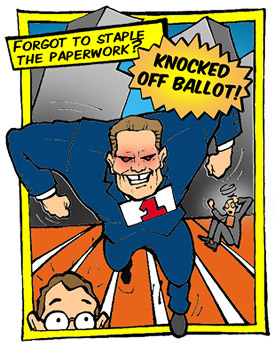 |
|
"It is not clear that any of these rules prevent fraud...It is incredibly trivial stuff that often trips up candidates."
|
Devil in the Details
Many incumbents, backed by their political party, have teams of lawyers who will go over a challenger's signatures, line by line, looking for minor mistakes like missing zip codes, misspellings, and voters who have signed petitions not knowing whether they live in the district or not.
In the past, candidates have been knocked off the ballot for such infractions as writing the abbreviation "St." instead of "Street" or forgetting to staple a cover sheet.
If the person gathering the signatures - called a petitioner - makes a mistake such as forgetting to write the borough on the bottom of the page, all of the signatures that he collected can be thrown out. If enough signatures are declared invalid, a candidate is eliminated.
This year, in the district 48 race in Coney Island and Gravesend Brooklyn one candidate was kicked off of the ballot because he petitioned under his common name Tony Eisenberg, rather than under his legal name Anatoly Eyzenberg. The Russian immigrant who has been in the United States for 23 years said that when he came to New York, he "Americanized" his name. "My wife, everyone calls me Tony - I forgot my name was Anatoly," he joked.
The argument for such complex and obscure rules is to protect against fraud and allow only serious candidates on the ballot.
Every so often, the press gleefully reports some obvious example of fraud; a court challenge to the petitions of Manhattan City Councilmember Alan Gerson revealed that they included the signature of a dead woman. Elsie Roloan, who died on June 22, nevertheless signed Gerson's petition four days later.
Gerson, who serves lower Manhattan's district 1, denied any wrongdoing and told the New York Post that it is nearly impossible for a candidate to know what is happening during the signature gathering. "I have no control or oversight over the petitions in question," Gerson said. "This suit is a total waste of the judiciary's time. It's frivolous."
Even those who believe that dead people should not be involved in the political process have to agree that such litigation, and the rules that encourage it, do not accomplish their supposed big-picture aim: Surely, nobody really doubts that an incumbent like Gerson is a serious candidate. Experts say that the rules, while useful as weapons by political opponents, in fact do little to protect voters.
"It is not clear that any of these rules prevent fraud," said Columbia Law Professor Richard Briffault. "It is incredibly trivial stuff that often trips up candidates."
The Board of Election officials and judges ruling on the cases often owe their seats to the same party organizations trying to get rid of all challengers, and so are slow to accept reforms.
In the case of Councilmember Allan Jennings, the judge who knocked him off the ballot, Justice Janice Taylor, was backed by the Queens Democratic Party, which a decade ago helped her reach the bench despite a rating of "not qualified" by the bar association, according to a recent article in the Daily News.
And even for candidates who admit the system is a mess, ballot challenges become a necessary part of the political process.
After being knocked off the ballot in 2001, Washington Heights council candidate Victor Bernace, a lawyer who usually defends cab drivers, learned the complexities of election law and this year challenged a less experienced candidate, Pedro Morillo. Bernace set up a headquarters at his kitchen table with five borrowed laptop computers and friends who worked round the clock to look for errors in his opponent's signatures.
"You get hit by the system, then you learn, then you do it to someone else," said Bernace. "It's really a silly game."
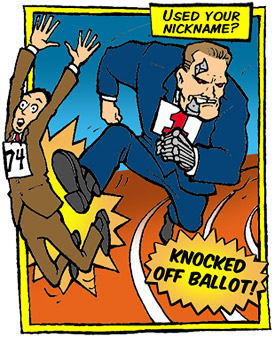 |
|
"My wife, everyone calls me Tony," says Anatoly Eyzenberg, who was kicked off the ballot for using the name he has had since immigrating 23 years ago.
|
National Embarrassment
New York's Byzantine election laws received national attention in 2000, when Arizona Senator John McCain, who was running against George W. Bush in the Republican Presidential Primary, was knocked off of the ballot by his own party.
At the time, New York's election law required that a candidate collect thousands of signatures from each of the 31 congressional districts across the state, including areas of the city with few Republicans. Governor George Pataki, who supported Bush, used the laws to keep McCain out of the running.
McCain, who had already won the New Hampshire Primary, denounced the state's "Stalinist politics."
A federal judge eventually put McCain back on the ballot, but not before dozens of editorials across the country mocked New York's political process. That same year, Republican Steve Forbes spent $750,000 just to get on the primary ballot.
After the national embarrassment, state lawmakers instituted reforms. But local races are still decided as much in the courtroom as in the voting booth. The battles make for some very bizarre tales.
Bumped By The Dead
Even after James Davis was shot and killed in City Hall in July, lawyers for the slain council member continued their challenge of Davis's opponent Anthony Herbert in district 35 in central Brooklyn.
The Board of Elections removed Herbert because dozens of the petition sheets failed to include the city and county of the person collecting the signatures. To avoid such problems, many candidates have the name of the city and county pre-printed on the petition sheet, but Herbert, who was running for the first time, overlooked the detail. Even though Herbert collected more than 2,000 signatures, he found himself with half the amount needed after the challenge.
"Anthony Herbert may go down in history as just another exhibit showing that you don't challenge insiders," said Herbert's lawyer Victor Bernace. "Even a dead man can kick you off the ballot in New York."
Herbert, reportedly enraged at being unjustly maneuvered off the ballot by his party, has announced that he will run for the seat in the general election on the Republican line.
Fighting the Family
Bronx Candidate Luana Rodriguez found herself fighting the most powerful political family in the Bronx when she tried to challenge 24-year-old Councilmember Joel Rivera in district 15.
Councilmember Rivera's father is Jose Rivera, State Assemblyman and chair of the Bronx Democratic Party. Joel's mother is the district manager of community board 6 and her son's former campaign manager. Joel's sister is the deputy chief at the Bronx Board of Elections.
The Rivera's used all their forces to work to knock her off the ballot, Rodriguez said. She was disqualified when two of her witnesses, those who collected and verified the petitions, were found to not be registered Democrats living in the district.
Rodriguez said she never stood a chance in challenging the ruling. "I counted 10 lawyers for the other side," she said.
 |
|
"I counted 10 lawyers for the other side," said Luana Rodriguez, who was kicked off the ballot by the Rivera clan of the Bronx.
|
Borough Park Brawl
In Borough Park, Brooklyn a former council member, Noach Dear, who was barred from running this year by the term-limits law, tried to sue his way onto the ballot. He even circulated petitions, gathering signatures from voters who had no idea that he cannot legally run again until 2005.
Incumbent Councilmember Simcha Felder filed a counter lawsuit to block Dear from appearing on the ballot and threatened to garnish his salary if elected. "If he's circulating petitions, he's deceiving voters," said Felder.
After months of legal wrangling, Dear was barred from running. Those who see this as a triumph for democracy, or at least for the rule of law, may find it bracing to learn that, this fall, Councilmember Felder is running unopposed on the Democratic, Republican, and Conservative party lines.
Worse Than The Worst Country Club
Even Republicans, who have a slim chance of winning in a Democratic district, wage fierce battles with each other before primary day.
In district 32 Republican Richard Iritano said he was locked out of the process when the party refused to even talk to him. Iritano was then knocked off of the ballot after the Board of Elections ruled that 521 of his petition signatures were altered. Iritano said that the claim was "complete nonsense because all of the petitions were collected by myself and my mother."
Republican Michael Mossa challenged Iritano's petitions, and when Iritano tried to defend his case in court, he said that the judge reprimanded him for wasting the court's time. "The whole campaign was an exercise in futility," said Iritano. "I haven't seen this kind of exclusionary behavior even in the worst country clubs."
Chances for Reform?
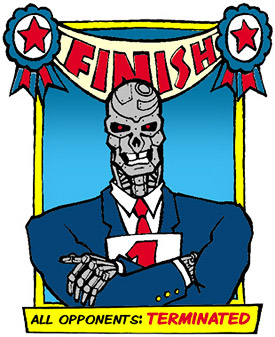 |
Reforming New York's laws is a nearly impossible undertaking given that political parties and incumbents in power see the system as working just fine. And most election-reform groups in the state work on other issues like same-day registration and poll worker training, not trying to rewrite election procedures that have been in operation since 1880.
There have been some minor changes in recent years, trying to cut down on some of the obscure regulations. A series of federal lawsuits have overturned some state rulings and some judges have been shamed into being more lenient.
Experts concede that these have not been enough. "There is a sense across the country that New York has the worst laws in the country," said Briffault.
These laws are not just bad for candidates, but for voters.
"Often it appears that candidates spend more time in court trying to knock each other from the ballot than they do explaining themselves to potential voters," Governor Mario Cuomo wrote in the New York Law Journal. "The State has no interest in denying qualified candidates an ability to be on the ballot and to be judged on their own merit. Unfortunately, New York's ballot access law does just that."
*******
Campaign 2003 -- Election Coverage:
• A Dozen Council Races to Watch
• A Brief History of Election Law in New York
• Gotham Gazette Looks at City Council Campaign 2003
*******
Series of Campaign Tangle articles from 2001:
• Campaign Tangle Begins
• A City of Challenges
• The Rejected Candidates
• Chaos and Confusion
• The Battle for District Attorney
• Disillusioned Candidates




